
U.S. GDP has grown steadily since the end of the Great Recession, and GDP per capita stands at $62,590, a record high. By these benchmarks, the United States is in a period of historic prosperity.
As with any single economic measure, however, this data falls short of painting a complete picture. To better capture prosperity at an individual level in a given area, the United Nations Development Program uses the Human Development Index, or HDI. The HDI is based on three core concepts: public health, education, and standard of living.
To identify the best counties to live in every state, 24/7 Wall St. constructed an index of three measures inspired by the HDI: poverty, the percentage of adults who have at least a bachelor’s degree, and average life expectancy at birth.
Only counties with populations of at least 10,000 were considered. County equivalents like Census areas, parishes, and independent cities were all included in our analysis. Data on life expectancy is from the Institute for Health Metrics and Evaluation, an independent population health research center at the University of Washington. We also considered April 2019 unemployment rates from the Bureau of Labor Statistics.
Unlike the worst counties to live in every state, nearly all of the counties on this list have higher than average educational attainment rates, lower than average poverty rates, and longer than average life expectancy at birth. Most also contain a major city or are in close proximity to one. Cities that counties on this list are within commuting distance of include Atlanta, Boston, Kansas City, Minneapolis, New York, San Francisco, and Washington D.C.
As with most desirable places to live, many of the counties on this list are prohibitively expensive for most Americans. In fact, well over half of the counties on this list also have the most expensive housing markets in the state.
Click here to see the best county to live in every state

Alabama: Shelby County
> 5-yr. population change: +6.9% (state: +1.5%)
> Poverty rate: 8.3% (state: 18.0%)
> Adults with a bachelor’s degree: 42.2% (state: 24.5%)
> Life expectancy: 79.5 years (state: 75.7 years)
In Shelby County, 42.2% of adults have a bachelor’s degree or higher, well above the 24.5% bachelor’s degree attainment rate across Alabama as a whole. Incomes tend to rise with educational attainment, and in Shelby County, just 8.3% of the population lives below the poverty line, less than half the 18.0% state poverty rate. Additionally, with a median annual household income of $74,063, Shelby is the richest county in the state.
Like most counties on this list, Shelby County is growing rapidly. In the last five years, the county’s population grew by 6.9%, more than quadruple Alabama’s 1.5% population growth over that time.
See all stories featuring: Alabama
[in-text-ad]

Alaska: Juneau City and Borough
> 5-yr. population change: +2.5% (state: +3.9%)
> Poverty rate: 7.4% (state: 10.2%)
> Adults with a bachelor’s degree: 40.3% (state: 29.0%)
> Life expectancy: 80.3 years (state: 78.4 years)
The Juneau Borough is coterminous with the city of the same name, Alaska’s state capital. Juneau is the only borough or county equivalent in the state where more than 40% of adults have a bachelor’s degree. Joblessness is also less of a problem in Juneau than it is statewide. Only 4.6% of workers in the city are out of a job, well below the 6.5% state unemployment rate.
Due in part to both a well-educated population and a relatively strong job market, serious financial hardship is not as common in Juneau as it is in the state as a whole. Just 7.4% of the local population lives below the poverty line, compared to 10.2% of Alaskans.
See all stories featuring: Alaska

Arizona: Maricopa County
> 5-yr. population change: +8.2% (state: +6.2%)
> Poverty rate: 15.7% (state: 17.0%)
> Adults with a bachelor’s degree: 31.4% (state: 28.4%)
> Life expectancy: 80.1 years (state: 79.6 years)
Maricopa County includes the city of Phoenix. The most populous county in Arizona, it is also one of the fastest growing. The county is now home to 4.2 million people, an 8.2% increase from five years prior. Over the same period, Arizona’s population grew by 6.2%. The county’s rapid growth may be driven in part by the strong job market and relatively high paying jobs in the country. Just 3.7% of Maricopa County’s labor force is unemployed, the lowest unemployment rate in the state. Additionally, with a median household income of $58,580 a year, it is the richest county in the state.
See all stories featuring: Arizona

Arkansas: Benton County
> 5-yr. population change: +13.4% (state: +2.1%)
> Poverty rate: 10.5% (state: 18.1%)
> Adults with a bachelor’s degree: 31.7% (state: 22.0%)
> Life expectancy: 79.4 years (state: 76.2 years)
Benton County is located in the northwestern corner of Arkansas, just north of Fayetteville. By far the fastest growing county in the state, the Benton’s population grew by 13.4% in the last five years, more than six times the state’s 2.1% population growth. Benton County residents are more likely to have a college education and less likely to live in poverty than the typical Arkansas resident.
As is often the case in counties on this list, Benton County is not a cheap place to live relative to the rest of the state. With a median home price of $193,647, according to the National Association of Realtors, Benton ranks as the county with the most expensive housing market in the state.
See all stories featuring: Arkansas
[in-text-ad-2]

California: Marin County
> 5-yr. population change: +3.2% (state: +4.4%)
> Poverty rate: 8.1% (state: 15.1%)
> Adults with a bachelor’s degree: 57.5% (state: 32.6%)
> Life expectancy: 83.8 years (state: 80.8 years)
Marin County is located on the other side of the Golden Gate bridge from San Francisco. It is one of only a few dozen counties nationwide where more than 50% of adults have a bachelor’s degree. Higher-paying jobs often require at least a college diploma, and in Marin County, most households have an income over $100,000 a year.
High-income, highly educated populations typically report better health outcomes. With a life expectancy of 83.8 years, three years longer than life expectancy in California and nearly five years above life expectancy nationwide, Marin County ranks as the healthiest county in the state.
See all stories featuring: California

Colorado: Pitkin County
> 5-yr. population change: +4.4% (state: +7.8%)
> Poverty rate: 7.1% (state: 11.5%)
> Adults with a bachelor’s degree: 61.2% (state: 39.4%)
> Life expectancy: 86.5 years (state: 80.2 years)
Pitkin County, Colorado, is located southwest of Denver in the Rocky Mountains and includes the resort towns of Snowmass and Aspen. Pitkin ranks as the best educated county in the state and one of the best educated in the country as 61.2% of adults have a bachelor’s degree — well above the 39.4% and 30.9% shares across the state and country, respectively. Pitkin is also one of the healthiest counties in the country. Life expectancy in Pitkin County is 86.5 years, over seven years longer than the life expectancy nationwide and nearly the highest in the U.S., second only to the 86.8-year life expectancy in nearby Summit County, Colorado.
See all stories featuring: Colorado
[in-text-ad]

Connecticut: Fairfield County
> 5-yr. population change: +3.1% (state: +0.6%)
> Poverty rate: 8.8% (state: 10.1%)
> Adults with a bachelor’s degree: 46.5% (state: 38.4%)
> Life expectancy: 81.8 years (state: 80.6 years)
Fairfield County is located in Connecticut’s southwest corner. County residents live within commuting distance of high-paying jobs in New York City, and the typical county household earns $89,773 a year, the most of any of the eight counties in the state. High income areas are typically home to well-educated populations, and Fairfield is the best educated county in the state. The bachelor’s degree attainment rate among adults in Fairfield is 46.5%, well above the comparable rates of 38.4% statewide and 30.9% nationwide.
See all stories featuring: Connecticut

Delaware: New Castle County
> 5-yr. population change: +2.8% (state: +4.8%)
> Poverty rate: 11.9% (state: 12.1%)
> Adults with a bachelor’s degree: 35.7% (state: 31.0%)
> Life expectancy: 79.0 years (state: 78.7 years)
New Castle County, the northernmost county of the three that make up Delaware, is the best county to live in the state. The county’s 11.9% poverty rate is the lowest in the state and slightly below the 12.1% state poverty rate. New Castle is also by far the wealthiest county in Delaware, with a median annual household income of $68,336, over $10,000 higher than the median income in the state’s other two counties. The county contains Wilmington, the most populous city in the state, and area residents live within commuting distance of Philadelphia.
See all stories featuring: Delaware

Florida: St. Johns County
> 5-yr. population change: +18.3% (state: +7.4%)
> Poverty rate: 9.1% (state: 15.5%)
> Adults with a bachelor’s degree: 43.0% (state: 28.5%)
> Life expectancy: 80.7 years (state: 79.5 years)
St. Johns County, Florida, is located just south of Jacksonville, bordered by the St. Johns River to the west and the Atlantic Ocean to the east. With a median annual household income of $73,640, St. Johns is the wealthiest county in Florida. It is also one of only two counties in the state where fewer than one in 10 residents live below the poverty line.
Higher-income Americans often have better access to quality medical care and can afford a greater range of healthy options related to diet and lifestyle, and as a result they typically lead longer, healthier lives. In St. Johns County, life expectancy at birth is 80.7 years, about a year longer than it is across the state as a whole.
See all stories featuring: Florida
[in-text-ad-2]
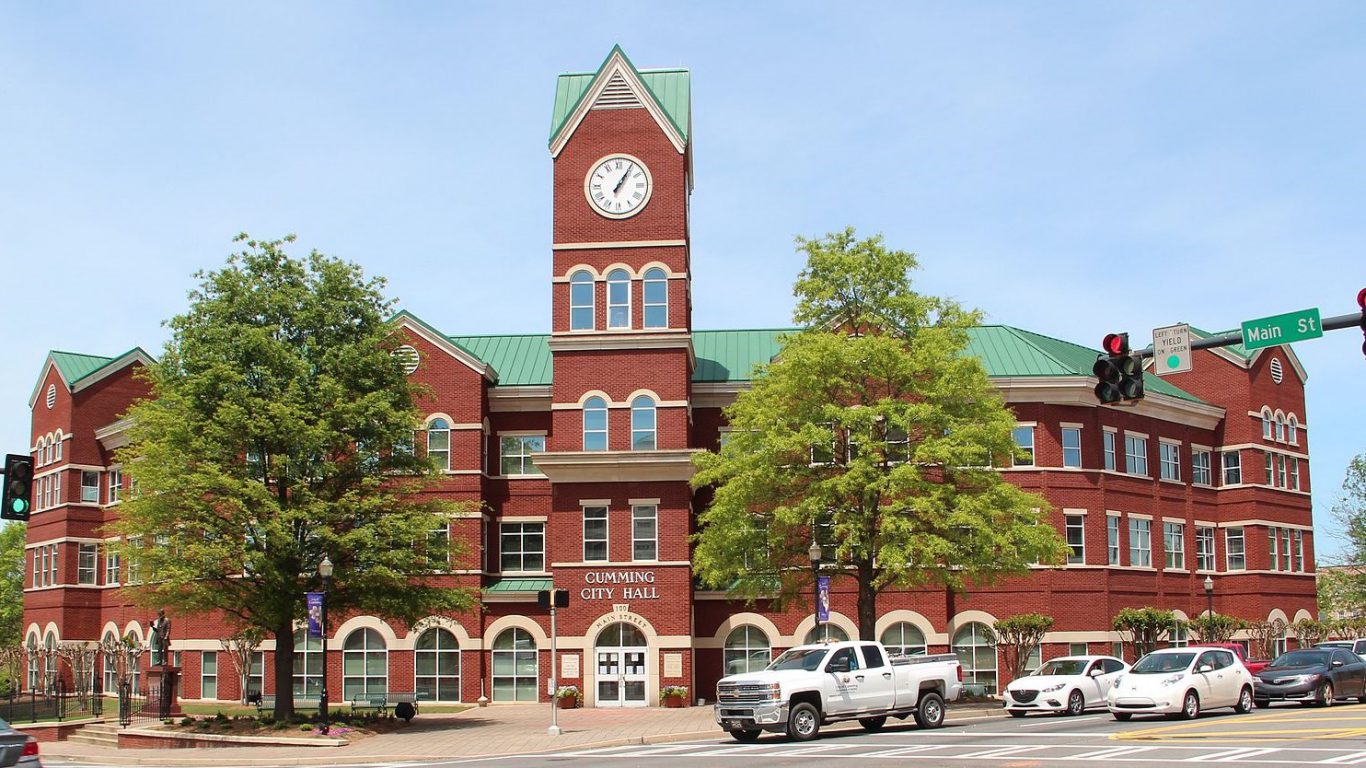
Georgia: Forsyth County
> 5-yr. population change: +19.3% (state: +5.0%)
> Poverty rate: 6.5% (state: 16.9%)
> Adults with a bachelor’s degree: 50.2% (state: 29.9%)
> Life expectancy: 81.3 years (state: 77.4 years)
Forsyth County, Georgia, is located just north of Atlanta. It is one of only a handful of counties in the state where life expectancy at birth exceeds 80 years, and one of only two where over half of all adults have a bachelor’s degree.
Like many counties on this list, Forsyth County is growing rapidly. In the last five years, the number of people living in the county spiked by 19.3%, nearly four times Georgia’s 5.0% population growth over the same period. The most desirable places to live are not often cheap, and Forsyth County is no exception. With a median home value of $391,587, according to data provided by the National Association or Realtors, Forsyth has the most expensive housing market of any county in the state.
See all stories featuring: Georgia

Hawaii: Honolulu County
> 5-yr. population change: +3.6% (state: +4.3%)
> Poverty rate: 9.1% (state: 10.3%)
> Adults with a bachelor’s degree: 34.0% (state: 32.0%)
> Life expectancy: 81.4 years (state: 81.2 years)
Honolulu County, which includes the city of the same name, is the only county in Hawaii where more than one in every three adults have a bachelor’s degree. Greater educational attainment typically leads to higher paying jobs, and it is likely no coincidence that Honolulu is also the only county in the state where most households earn over $80,000 a year.
Like many other densely-populated, urban and suburban counties on this list, Honolulu has a low unemployment rate. Just 2.6% of workers in the county are out of a job, the lowest unemployment rate of any county in the state and well below the 3.6% national unemployment rate.
See all stories featuring: Hawaii
[in-text-ad]

Idaho: Teton County
> 5-yr. population change: +7.7% (state: +5.7%)
> Poverty rate: 8.3% (state: 14.5%)
> Adults with a bachelor’s degree: 42.5% (state: 26.8%)
> Life expectancy: 82.1 years (state: 79.5 years)
Teton County, located in eastern Idaho along the Wyoming state border, ranks as the best county to live in the state. Just 8.3% of county residents live below the poverty line, the lowest poverty rate of any Idaho county. Americans facing serious financial hardship have less access to quality health care and the available range of healthy diet and lifestyle options they can afford and often report worse than average health outcomes. Teton County’s low poverty rate likely partially explains the relatively long, healthy lives of area residents. Life expectancy at birth in the county is 82 years, about three and a half years above life expectancy across the state as a whole.
See all stories featuring: Idaho

Illinois: DuPage County
> 5-yr. population change: +1.4% (state: +0.2%)
> Poverty rate: 6.8% (state: 13.5%)
> Adults with a bachelor’s degree: 48.0% (state: 33.4%)
> Life expectancy: 81.9 years (state: 79.0 years)
DuPage County is located just west of Chicago, well within commuting distance of the largest city in the Midwest. Partially as a result, the county’s 2.9% unemployment rate is the lowest of any county in the state and well below the 3.6% national unemployment rate.
DuPage residents are also more likely to lead long, healthy lives than those in other parts of the state. Life expectancy at birth in the county is nearly 82 years, about three years longer than life expectancy across Illinois. Partially as a result, DuPage ranks as the healthiest county in the state.
See all stories featuring: Illinois

Indiana: Hamilton County
> 5-yr. population change: +12.2% (state: +2.0%)
> Poverty rate: 5.0% (state: 14.6%)
> Adults with a bachelor’s degree: 57.5% (state: 25.3%)
> Life expectancy: 81.8 years (state: 77.7 years)
Located just north of Indianapolis, Hamilton County is like many others on this list in that its residents have access to jobs and entertainment options in a major city. Partially as a result, the county’s unemployment rate is low at just 2.3%. Many of the jobs county residents have are high paying as Hamilton is the only county in the state where most households earn over $90,000 a year.
The county’s location and strong economic conditions likely make it an attractive place to live for new residents and families. In the last five years, Hamilton County’s population grew by 12.2%, the largest increase of any county in the state and more than six times Indiana’s 2.0% population growth over the same period.
See all stories featuring: Indiana
[in-text-ad-2]
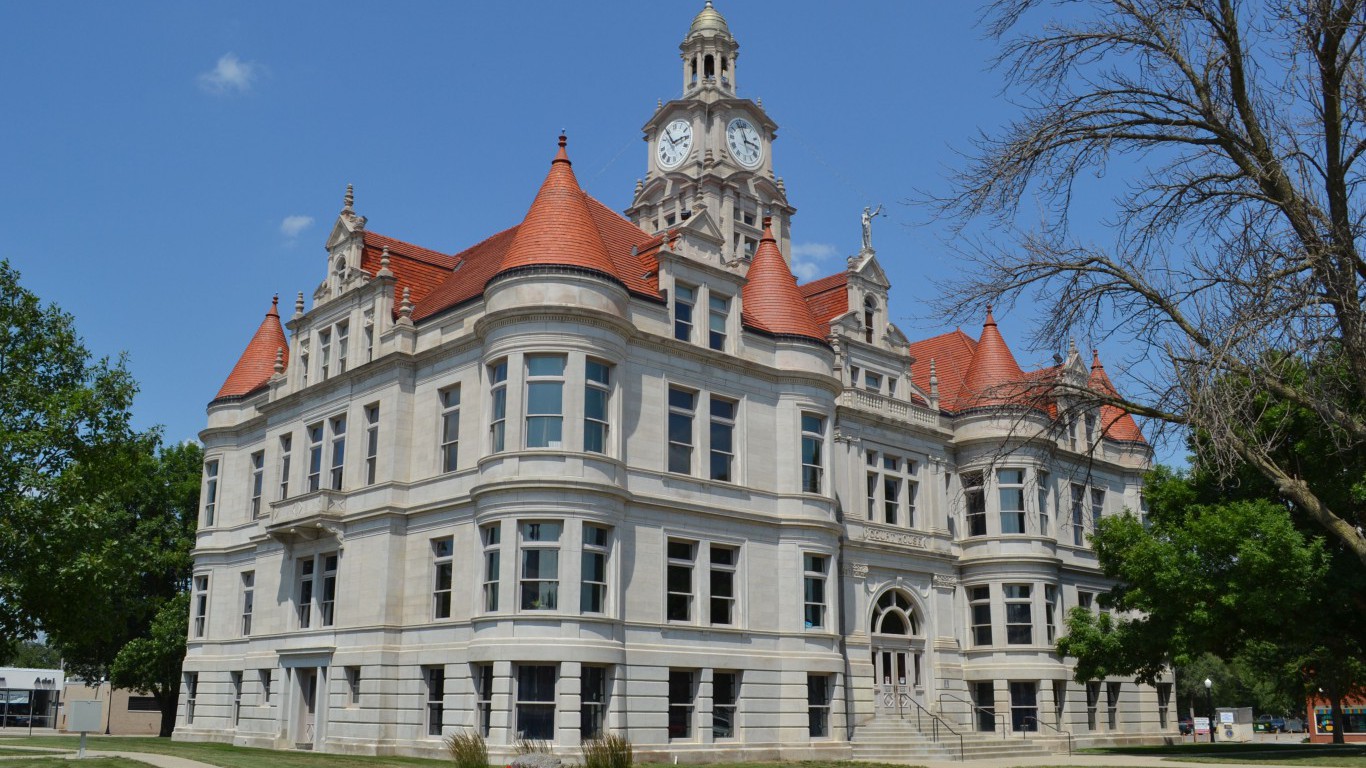
Iowa: Dallas County
> 5-yr. population change: +20.7% (state: +2.3%)
> Poverty rate: 5.4% (state: 12.0%)
> Adults with a bachelor’s degree: 49.1% (state: 27.7%)
> Life expectancy: 81.5 years (state: 79.7 years)
Dallas ranks as the best county to live in in Iowa. Located just west of the state capital of Des Moines, county residents live within commuting distance of jobs and cultural attractions of a major city. A relatively affluent area, Dallas County is the only county in the state where more than one in every 10 households earn at least $200,000 a year. The county is also notable for having relatively minimal financial hardship. Just 5.4% of residents live below the poverty line, less than half the 12.0% poverty rate across Iowa.
Across Iowa, joblessness is relatively uncommon. Just 2.4% of workers in the state are out of a job, well below the 3.6% national unemployment rate. In Dallas County, unemployment is even less common. The county’s 1.5% unemployment rate is nearly the lowest of any U.S. county or county equivalent.
See all stories featuring: Iowa

Kansas: Johnson County
> 5-yr. population change: +6.0% (state: +1.8%)
> Poverty rate: 5.6% (state: 12.8%)
> Adults with a bachelor’s degree: 54.6% (state: 32.3%)
> Life expectancy: 81.7 years (state: 78.7 years)
Johnson County, Kansas, is located just outside of Kansas City, one of the largest cities in the Midwest. The richest county in the state, Johnson County’s median household income of $81,121 is about $25,600 greater than what the typical Kansas household earns. As is often the case in affluent communities, residents of Johnson County are generally healthy. Life expectancy at birth in the county is nearly 82 years, the highest of any county in the state and well above the 79 year life expectancy nationwide.
See all stories featuring: Kansas
[in-text-ad]

Kentucky: Oldham County
> 5-yr. population change: +7.1% (state: +1.9%)
> Poverty rate: 5.6% (state: 18.3%)
> Adults with a bachelor’s degree: 40.4% (state: 23.2%)
> Life expectancy: 79.6 years (state: 76.3 years)
With a median annual household income of $46,535, more than $10,000 below the national median, Kentucky is one of the poorest states in the country. Not all parts of the state are poor, however. In Oldham County, located along the Ohio River just outside of Louisville, more than one in every 10 households earn at least $200,000 a year, and at least half of all households earn $92,000 or more a year.
Not only the wealthiest, Oldham County is also the healthiest county in Kentucky. The county’s average life expectancy at birth is nearly 80 years — more than three years longer than it is across the state.
See all stories featuring: Kentucky

Louisiana: St. Tammany Parish
> 5-yr. population change: +6.4% (state: +3.0%)
> Poverty rate: 10.8% (state: 19.6%)
> Adults with a bachelor’s degree: 32.5% (state: 23.4%)
> Life expectancy: 77.6 years (state: 75.8 years)
St. Tammany Parish, Louisiana is located directly across Lake Pontchartrain from New Orleans. Serious financial hardship is far less common in the parish than it is in much of the rest of the state as just 10.8% of residents live below the poverty line, nearly half the 19.6% state poverty rate.
Louisiana as a whole ranks among the states with the lowest life expectancy. Even in St. Tammany Parish, one of the healthiest regions in the state, life expectancy is 77.6 years, about a year and a half below the national average.
See all stories featuring: Louisiana

Maine: Cumberland County
> 5-yr. population change: +2.5% (state: +0.1%)
> Poverty rate: 10.7% (state: 12.9%)
> Adults with a bachelor’s degree: 45.0% (state: 30.3%)
> Life expectancy: 80.4 years (state: 79.3 years)
Cumberland County is by far the most educated county in Maine. Of all county adults, 45% have a bachelor’s degree or higher, at least 10 percentage points above any other county in the state.
Population growth in Maine has been stagnant in recent years, but Cumberland County, located in southwestern Maine, is one of only a few counties in the state to report population growth. With the city of Portland serving as the county seat, the number of people living in Cumberland County climbed by 2.5% over the last five years, the most of any of the state’s 16 counties.
See all stories featuring: Maine
[in-text-ad-2]

Maryland: Howard County
> 5-yr. population change: +8.3% (state: +3.6%)
> Poverty rate: 5.2% (state: 9.7%)
> Adults with a bachelor’s degree: 61.2% (state: 39.0%)
> Life expectancy: 83.0 years (state: 79.2 years)
Largely situated in between Baltimore and Washington D.C., Howard County residents live within commuting distance of two major cities. Partially as a result, the county’s 2.5% unemployment rate is the lowest of any county or county equivalent in the state and among the lowest in the country.
Due in part to the concentration of government contractors in the area, including some of America’s biggest defense contractors, many jobs in the Washington D.C. region pay high salaries. In Howard County, the poverty rate is far lower than average, and the typical household earns over $115,000 a year, more than in all but two other counties nationwide.
See all stories featuring: Maryland

Massachusetts: Middlesex County
> 5-yr. population change: +5.0% (state: +3.5%)
> Poverty rate: 8.2% (state: 11.1%)
> Adults with a bachelor’s degree: 54.1% (state: 42.1%)
> Life expectancy: 81.6 years (state: 80.4 years)
Massachusetts has the best-educated population of any state in the country, with a bachelor’s degree attainment rate of 42.1%. In Middlesex County, which covers areas north and northeast of Boston, including Cambridge, MIT, and Harvard University, over half of all adults have a bachelor’s degree or higher.
Areas with better-educated populations are generally more prosperous, and serious economic hardship is relatively rare in Middlesex County. Just 8.2% of county residents live below the poverty line, well below the 11.1% state poverty rate and the 14.6% national rate.
See all stories featuring: Massachusetts
[in-text-ad]

Michigan: Leelanau County
> 5-yr. population change: -0.5% (state: +0.3%)
> Poverty rate: 7.7% (state: 15.6%)
> Adults with a bachelor’s degree: 40.8% (state: 28.1%)
> Life expectancy: 83.1 years (state: 78.3 years)
Leelanau County is located in northwestern Michigan along the shores of Lake Michigan. With an average life expectancy of 83 years, about five years longer than life expectancy across the state, Leelanau is one of the healthiest counties in the United States. College-educated adults have a greater sense of control over their lives and tend to exhibit healthier behaviors and lifestyles than those with lower educational attainment. In Leelanau County, 40.8% of adults have a bachelor’s degree or higher, well above the 28.1% bachelor’s degree attainment rate across the state as a whole.
See all stories featuring: Michigan

Minnesota: Carver County
> 5-yr. population change: +8.1% (state: +3.3%)
> Poverty rate: 4.0% (state: 10.5%)
> Adults with a bachelor’s degree: 47.5% (state: 34.8%)
> Life expectancy: 82.8 years (state: 80.9 years)
Located just outside of Minneapolis, Carver County, like many other counties on this list, is within commuting distance of a major city. Access to one of the largest cities in the Midwest provides job opportunities to Carver County residents, which in turn reduces the incidence of serious financial hardship. Unemployment in the county stands at just 2.6%, and the poverty rate is just 4.0%, each well below the respective 3.3% and 10.5% rates statewide.
See all stories featuring: Minnesota

Mississippi: Rankin County
> 5-yr. population change: +5.3% (state: +0.6%)
> Poverty rate: 8.5% (state: 21.5%)
> Adults with a bachelor’s degree: 29.2% (state: 21.3%)
> Life expectancy: 78.4 years (state: 74.9 years)
With a 21.3% bachelor’s degree attainment rate, Mississippi ranks among the least educated states in the country. Even in Rankin County, located just east of the state capital of Jackson, just 29.1% of adults have a bachelor’s degree, a slightly smaller share than the 30.9% of American adults nationwide.
Despite the lower than average educational attainment, financial hardship is far less common in Rankin County than it is nationwide. Just 8.5% of county residents live below the poverty line, well below the 14.6% national poverty rate, which itself is far below Mississippi’s poverty rate of 21.5%.
See all stories featuring: Mississippi
[in-text-ad-2]

Missouri: Platte County
> 5-yr. population change: +8.2% (state: +1.6%)
> Poverty rate: 7.2% (state: 14.6%)
> Adults with a bachelor’s degree: 41.5% (state: 28.2%)
> Life expectancy: 80.4 years (state: 77.7 years)
Platte County, Missouri, is one of two counties on this list within commuting distance of Kansas City, one of the largest cities in the Midwest. The access to a major city provides greater job opportunities for county residents and reduces the likelihood of financial hardship. Unemployment in the county stands at just 2.3%, and the poverty rate is just 7.2%, each well below the respective 3.6% and 14.6% rates statewide.
Platte County residents are also more likely to live longer, healthier lives than those in much of the rest of the state. The county’s average life expectancy at birth is 80.4 years, nearly three years longer than the average life expectancy across Missouri.
See all stories featuring: Missouri

Montana: Gallatin County
> 5-yr. population change: +11.5% (state: +3.9%)
> Poverty rate: 13.0% (state: 14.4%)
> Adults with a bachelor’s degree: 48.8% (state: 30.7%)
> Life expectancy: 82.0 years (state: 78.9 years)
Gallatin County is located in southwestern Montana, sharing a border with both Idaho and Wyoming. By far the best educated county in the state, nearly half of all adults in the county have a bachelor’s degree or higher, compared to 30.7% of adults across Montana as a whole. Better-educated adults tend to live longer, healthier lives than those with lower educational attainment. Gallatin County’s average life expectancy at birth of 82 years is three years longer than the average life expectancy across the state.
See all stories featuring: Montana
[in-text-ad]
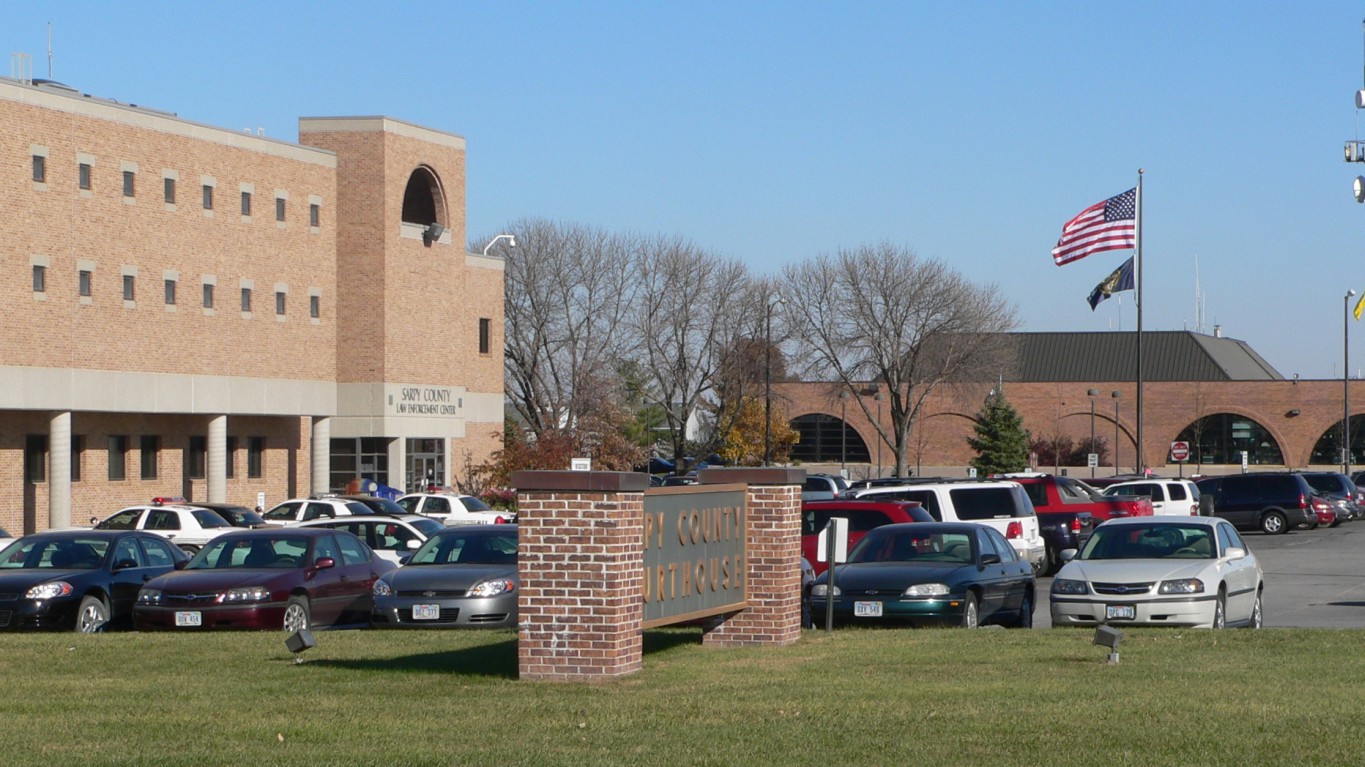
Nebraska: Sarpy County
> 5-yr. population change: +9.9% (state: +3.6%)
> Poverty rate: 5.3% (state: 12.0%)
> Adults with a bachelor’s degree: 39.5% (state: 30.6%)
> Life expectancy: 80.5 years (state: 79.6 years)
Sarpy County is located in eastern Nebraska, bordered on three sides by the Platte and Missouri Rivers, with the city of Omaha to the north. Serious financial hardship is relatively uncommon in county as just 5.3% of the population lives below the poverty line, less than half the poverty rate of 12.0% statewide. As is the case with many counties on this list, Sarpy also ranks as the richest county in the state, with a median annual household income of $75,752.
The high incomes and low poverty in Sarpy County are partially attributable to a highly-educated population. Nearly 40% of adults in the county have a bachelor’s degree or higher, compared to 30.6% of adults across the state as a whole.
See all stories featuring: Nebraska

Nevada: Douglas County
> 5-yr. population change: +1.2% (state: +6.8%)
> Poverty rate: 9.8% (state: 14.2%)
> Adults with a bachelor’s degree: 27.2% (state: 23.7%)
> Life expectancy: 81.1 years (state: 78.1 years)
Douglas County, located in western Nevada along Lake Tahoe, just south of Carson City, ranks as the best county to live in in the state. No other Nevada county with a population of 10,000 or more has a higher life expectancy than Douglas County — where the life expectancy at birth of 81.1 years is three years longer than the life expectancy across the state. Local residents are also more likely to be financially secure, as Douglas is one of only two Nevada counties where fewer than one in every 10 residents live below the poverty line.
See all stories featuring: Nevada

New Hampshire: Rockingham County
> 5-yr. population change: +2.2% (state: +1.1%)
> Poverty rate: 4.8% (state: 8.1%)
> Adults with a bachelor’s degree: 40.6% (state: 36.0%)
> Life expectancy: 80.6 years (state: 80.2 years)
Nearly every county in New Hampshire, a state characterized by overall low unemployment and poverty, ranks higher than the vast majority of U.S. counties as a desirable place to live. Of them, Rockingham County, located in southeastern New Hampshire and sharing a border with both Maine and Massachusetts, ranks the highest. Rockingham is the only county in the state where more than 40% of adults have a bachelor’s degree. It is also the only New Hampshire county with a poverty rate below 5%.
See all stories featuring: New Hampshire
[in-text-ad-2]

New Jersey: Somerset County
> 5-yr. population change: +3.0% (state: +1.9%)
> Poverty rate: 4.8% (state: 10.7%)
> Adults with a bachelor’s degree: 53.1% (state: 38.1%)
> Life expectancy: 82.0 years (state: 80.0 years)
Along with the best counties to live in Connecticut and New York state, Somerset County, New Jersey, is one of three counties on this list within commuting distance to New York City. Close proximity to the largest city in the United States provides county residents with access to a massive job market, and many of the available jobs are high paying. Just 2.4% of workers in Somerset County are unemployed, and over half of all households earn over $100,000 a year. Serious financial hardship is relatively rare in the county, as just 4.8% of residents live below the poverty line, less than half the 10.7% poverty rate across New Jersey.
See all stories featuring: New Jersey

New Mexico: Los Alamos County
> 5-yr. population change: +0.1% (state: +1.4%)
> Poverty rate: 5.1% (state: 20.6%)
> Adults with a bachelor’s degree: 65.5% (state: 26.9%)
> Life expectancy: 83.5 years (state: 78.4 years)
Los Alamos, located in north-central New Mexico, is the best county to live in the state and one of the best nationwide. The county is bolstered by the Los Alamos National Laboratory, a weapons development facility that employs nearly 12,000 people. Many jobs at the lab are high-skill, and partially as a result, 65.5% of Los Alamos County residents have a bachelor’s degree or higher, by far the largest share in the state. Additionally, only 5.1% of county residents live below the poverty line, less than one-quarter of the statewide poverty rate.
Los Alamos is located less than 200 miles east of McKinley County, the worst county to live in the state, where more than one in every three residents live below the poverty line.
See all stories featuring: New Mexico
[in-text-ad]

New York: Nassau County
> 5-yr. population change: +1.8% (state: +2.1%)
> Poverty rate: 5.9% (state: 15.1%)
> Adults with a bachelor’s degree: 44.4% (state: 35.3%)
> Life expectancy: 82.2 years (state: 80.4 years)
Nassau County is located on Long Island along the eastern border of Brooklyn and Queens. As is the case in two other counties on this list, close proximity to New York City — the largest city in the country — provides Nassau residents with a wide range of job opportunities. Just 2.9% of workers in the county are unemployed — compared to 3.9% of workers across New York state. As a result of the proximity to the city and the low unemployment, the likelihood of serious financial hardship is relatively low in the county. The county’s 5.9% poverty rate is less than half the 15.1% poverty rate across the state as a whole.
See all stories featuring: New York

North Carolina: Orange County
> 5-yr. population change: +5.9% (state: +5.3%)
> Poverty rate: 14.0% (state: 16.1%)
> Adults with a bachelor’s degree: 57.6% (state: 29.9%)
> Life expectancy: 80.8 years (state: 77.9 years)
Orange County is located in North Carolina’s Research Triangle region. The region is so named due in part to the presence of three major research Universities: University of North Carolina at Chapel Hill, Duke University, and North Carolina State University. Perhaps not surprisingly, Orange County is the best educated county in the state, with a 57.6% bachelor’s degree attainment rate.
Orange County residents are also generally healthy. Life expectancy at birth in the county is 80.8 years, about three years longer than it is across the state as a whole.
See all stories featuring: North Carolina

North Dakota: Burleigh County
> 5-yr. population change: +12.7% (state: +10.2%)
> Poverty rate: 8.5% (state: 11.0%)
> Adults with a bachelor’s degree: 35.1% (state: 28.9%)
> Life expectancy: 81.2 years (state: 80.0 years)
The county seat of Burleigh County, located in central North Dakota, is the state capital of Bismark, and the county ranks as the best to live in the state. Just 8.5% of county residents live below the poverty line, a smaller share than North Dakota’s 11.0% poverty rate. Life expectancy in Burleigh County is also about a year longer than the 80 year life expectancy across the state as a whole.
Like many counties on this list, Burleigh County is growing rapidly. In the last five years, the county’s population increased by 12.7%, a faster growth than the 10.2% statewide population growth and the 3.8% national population growth.
See all stories featuring: North Dakota
[in-text-ad-2]
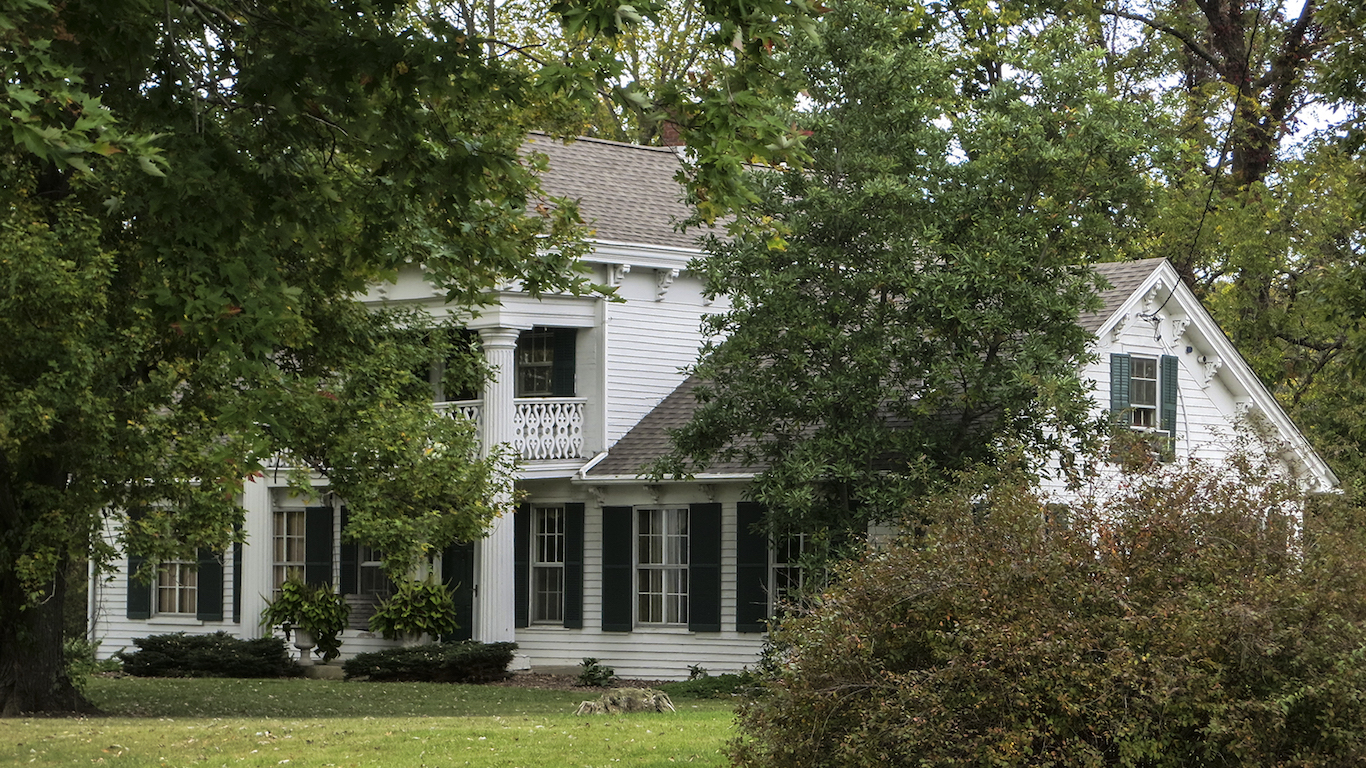
Ohio: Delaware County
> 5-yr. population change: +10.6% (state: +0.7%)
> Poverty rate: 5.1% (state: 14.9%)
> Adults with a bachelor’s degree: 53.8% (state: 27.2%)
> Life expectancy: 81.4 years (state: 77.9 years)
Sitting just north of Columbus, Delaware County is in close proximity to a major city. Access to the state capital and most populous city in the state provides job opportunities to Delaware County residents, which in turn reduces the likelihood of financial hardship. Unemployment in the county stands at just 2.3%, and the poverty rate is just 5.1%, each well below the respective 4.3% and 14.9% rates statewide.
Delaware County is also growing rapidly. In the last five years, the county’s population grew by 10.6%, more than 10 times the state’s 0.7% population growth over the same period.
See all stories featuring: Ohio

Oklahoma: Cleveland County
> 5-yr. population change: +6.8% (state: +3.9%)
> Poverty rate: 12.6% (state: 16.2%)
> Adults with a bachelor’s degree: 32.1% (state: 24.8%)
> Life expectancy: 78.7 years (state: 76.1 years)
The state of Oklahoma does not compare favorably to most U.S. states in key socioeconomic measures like educational attainment and poverty. Even the state’s best county to live in only compares slightly better than the national averages in these measures. In Cleveland County, which forms the southern part of the Oklahoma City metropolitan area, 12.6% of residents live in poverty, and 32.1% of adults have a bachelor’s degree, compared to national shares of 14.6% and 30.9%, respectively. In the vast majority of counties on this list the bachelor’s degree attainment rate is in excess of 40% and the poverty rate is under 10%.
See all stories featuring: Oklahoma
[in-text-ad]

Oregon: Washington County
> 5-yr. population change: +7.6% (state: +4.9%)
> Poverty rate: 10.3% (state: 14.9%)
> Adults with a bachelor’s degree: 42.4% (state: 32.3%)
> Life expectancy: 81.7 years (state: 79.4 years)
Washington County is not only the best county to live in Oregon, but also it is the richest county in the state. The typical household in the county earns $74,033 a year, well above the median annual household income across the state of $56,119. Serious financial hardship is also less common in Washington County as just 10.3% of residents live below the poverty line, compared to 14.9% of state residents.
Many of the counties on this list are within commuting distance of a major city, and, situated just west of Portland, Washington County is one of them.
See all stories featuring: Oregon

Pennsylvania: Chester County
> 5-yr. population change: +3.0% (state: +0.7%)
> Poverty rate: 6.9% (state: 13.1%)
> Adults with a bachelor’s degree: 51.0% (state: 30.1%)
> Life expectancy: 81.2 years (state: 78.8 years)
Chester County, Pennsylvania, is a wealthy suburban region west of Philadelphia. The county’s poverty rate is less than half the national rate of 14.6%, and the median annual household income of $92,417 is nearly $35,000 greater than the national median. As is usually the case in affluent counties, housing is very expensive. With a median home price of $384,436 according to the National Association of Realtors, Chester County has the most expensive housing market in the state.
Chester County is one of less than 50 counties with populations of at least 10,000 where more than half of all adults have a bachelor’s degree. A college degree generally contributes to improved employment opportunities and job stability, and Chester’s unemployment rate of 2.3% is one of the lower figures nationwide.
See all stories featuring: Pennsylvania

Rhode Island: Bristol County
> 5-yr. population change: -1.5% (state: +0.3%)
> Poverty rate: 7.0% (state: 13.4%)
> Adults with a bachelor’s degree: 46.8% (state: 33.0%)
> Life expectancy: 81.2 years (state: 79.8 years)
Bristol County is a small area of only about 25 square miles just north of Newport, Rhode Island. The county has the best-educated population in the state, with 46.8% of adults holding a bachelor’s degree or higher. Better-educated populations are typically more affluent, and serious financial hardship is relatively rare in Bristol County. Just 7.0% of the population lives below the poverty line compared to a poverty rate of 13.4% across Rhode Island.
As is often the case in areas with a well-educated, largely financially secure population, Bristol County residents are generally healthy. Life expectancy in the county is just over 81 years, about a year longer than it is statewide and two years longer that it is nationwide.
See all stories featuring: Rhode Island
[in-text-ad-2]

South Carolina: Beaufort County
> 5-yr. population change: +10.5% (state: +5.7%)
> Poverty rate: 11.9% (state: 16.6%)
> Adults with a bachelor’s degree: 39.8% (state: 27.0%)
> Life expectancy: 81.6 years (state: 76.9 years)
Beaufort County, South Carolina, part of the region that includes Hilton Head Island, ranks as the best county to live in the state, with above-average educational attainment and income.
Higher incomes and high educational attainment both correlate with longer, healthier lives. The national average life expectancy at birth is 79.1 years. Beaufort is the only county in South Carolina that has a higher life expectancy — and by a wide margin. Average life expectancy in the county at birth is 81.6 years.
See all stories featuring: South Carolina
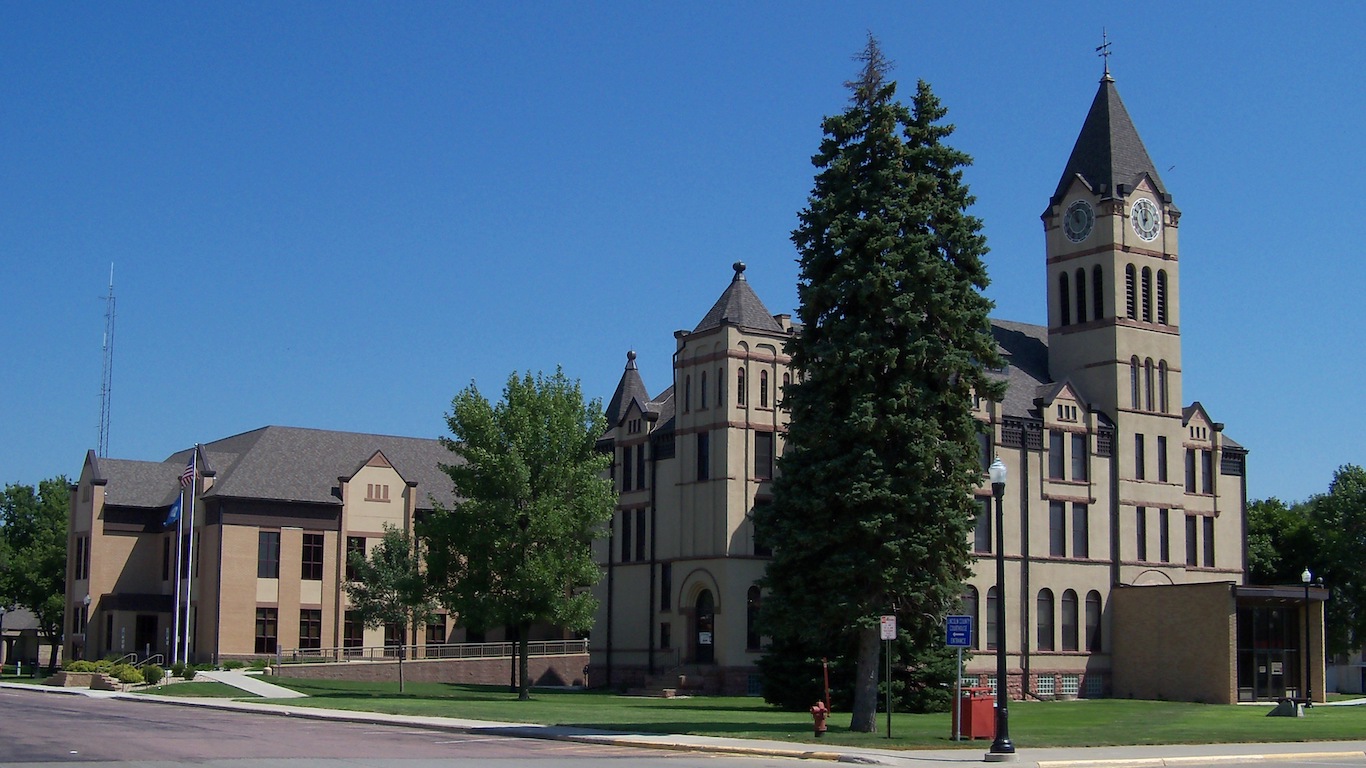
South Dakota: Lincoln County
> 5-yr. population change: +18.0% (state: +4.9%)
> Poverty rate: 3.0% (state: 13.9%)
> Adults with a bachelor’s degree: 41.0% (state: 27.8%)
> Life expectancy: 83.0 years (state: 79.6 years)
Lincoln County is located in southeast South Dakota, just south of Sioux Falls. The richest county in the state by median household income, very few county residents are struggling financially. Just 3.0% of area residents live below the poverty line, less than one-quarter of the state’s poverty rate of 13.9%. Widespread financial security in the area is partially the result of a strong job market, as the county’s unemployment rate of just 2.3% is well below the 2.8% statewide rate and the 3.6% national rate.
Like many other counties on this list, Lincoln County is growing rapidly. In the last five years, the county’s population spiked by 18.0%, more than any other county in South Dakota.
See all stories featuring: South Dakota
[in-text-ad]
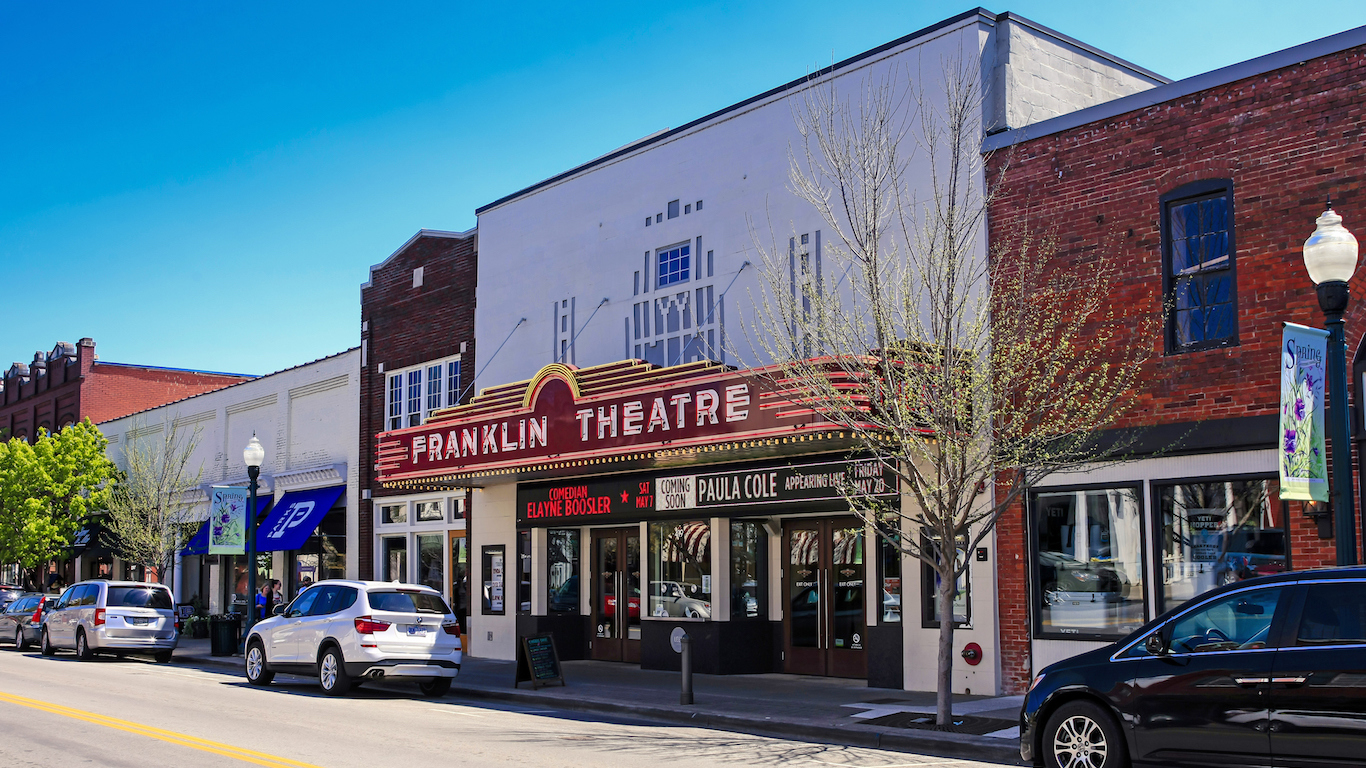
Tennessee: Williamson County
> 5-yr. population change: +15.2% (state: +3.8%)
> Poverty rate: 4.6% (state: 16.7%)
> Adults with a bachelor’s degree: 58.1% (state: 26.1%)
> Life expectancy: 81.9 years (state: 76.3 years)
Located just south of Nashville, Williamson County is one of many counties on this list located within commuting distance of a major city. Not only does proximity to a city provide county residents with access to cultural amenities, but it also provides them with employment opportunities and therefore reduces the likelihood of financial insecurity. Wiliamson is the only county in Tennessee with a poverty rate below 5%.
Williamson is also by far the healthiest county in Tennessee. The county’s average life expectancy at birth is about 82 years, nearly six years longer than the average life expectancy across the state as a whole.
See all stories featuring: Tennessee

Texas: Collin County
> 5-yr. population change: +15.9% (state: +8.8%)
> Poverty rate: 6.9% (state: 16.0%)
> Adults with a bachelor’s degree: 50.9% (state: 28.7%)
> Life expectancy: 82.0 years (state: 78.5 years)
Collin County, which is part of the greater Dallas-Ft. Worth metropolitan region and is home to the city of Plano, has a poverty rate of less than 7% and an adult bachelor’s degree attainment rate of greater than 50%.
Growing populations are often a sign of favorable economic and social conditions. In Collin County, the population has increased by 15.9% in the past five years. That is a large increase, even for Texas, which is one of the fastest growing states in the country. Collin’s population growth is nearly double the state’s population growth over the same period and more than four times the nation’s population growth of 3.8% over that period.
See all stories featuring: Texas

Utah: Summit County
> 5-yr. population change: +8.6% (state: +8.2%)
> Poverty rate: 7.5% (state: 11.0%)
> Adults with a bachelor’s degree: 53.5% (state: 32.5%)
> Life expectancy: 82.4 years (state: 79.9 years)
Utah’s Summit County can be found east of Salt Lake City. The county extends into the Uinta-Wasatch-Cache National Forest and is home to Park City, an upscale resort community. As in other counties on this list, Summit’s population is well educated. Over half of all adults in the county have a bachelor’s degree or higher, the largest share in Utah. The county is also one of the more affluent, with the typical household earning about $95,000 year, also the highest median annual household income of any county in the state.
See all stories featuring: Utah
[in-text-ad-2]

Vermont: Chittenden County
> 5-yr. population change: +2.7% (state: -0.1%)
> Poverty rate: 11.3% (state: 11.4%)
> Adults with a bachelor’s degree: 49.6% (state: 36.8%)
> Life expectancy: 81.4 years (state: 80.2 years)
Chittenden County, Vermont, includes the state’s most populous city, Burlington, which is home to a number of postsecondary institutions, including the University of Vermont. A high concentration of colleges and universities often coincides with higher regional educational attainment, and nearly 50% of county adults have a bachelor’s degree, compared to 30.9% of adults nationwide.
A college degree generally contributes to improved employment opportunities and job stability. Chittenden County’s 1.3% unemployment rate is the lowest in the state and is tied with Story County, Iowa, for the lowest of any large county in the United States.
See all stories featuring: Vermont

Virginia: Falls Church
> 5-yr. population change: +12.5% (state: +4.4%)
> Poverty rate: 2.9% (state: 11.2%)
> Adults with a bachelor’s degree: 78.1% (state: 37.6%)
> Life expectancy: 81.8 years (state: 79.2 years)
Falls Church, Virginia, an independent city, is about a 20 minute drive west of Washington, D.C. Some of the most affluent, highly-educated places in the United States can be found in the greater D.C. region, serving as bedroom communities for the researchers, educators, and lawyers who work in the nation’s capital.
Close to 80% of Falls Church’s adults have a bachelor’s degree, more than any other county or county equivalent in the country. More than one in four households have an annual income of $200,000 or more, compared to just 6.3% of households nationwide.
See all stories featuring: Virginia
[in-text-ad]

Washington: San Juan County
> 5-yr. population change: +3.1% (state: +6.4%)
> Poverty rate: 10.7% (state: 12.2%)
> Adults with a bachelor’s degree: 48.3% (state: 34.5%)
> Life expectancy: 83.7 years (state: 80.0 years)
San Juan County, the best county to live in Washington, is in the northwest corner of the state and is entirely located on a group of islands between the U.S. mainland and Vancouver Island, Canada. San Juan has the longest life expectancy of any county in the state and one of the longest in the country. The county’s average life expectancy at birth is 83.7 years, 13th highest among U.S. counties and 4.6 years higher than the national average life expectancy. Poverty is also less common in San Juan than in much of the rest of the state.
See all stories featuring: Washington
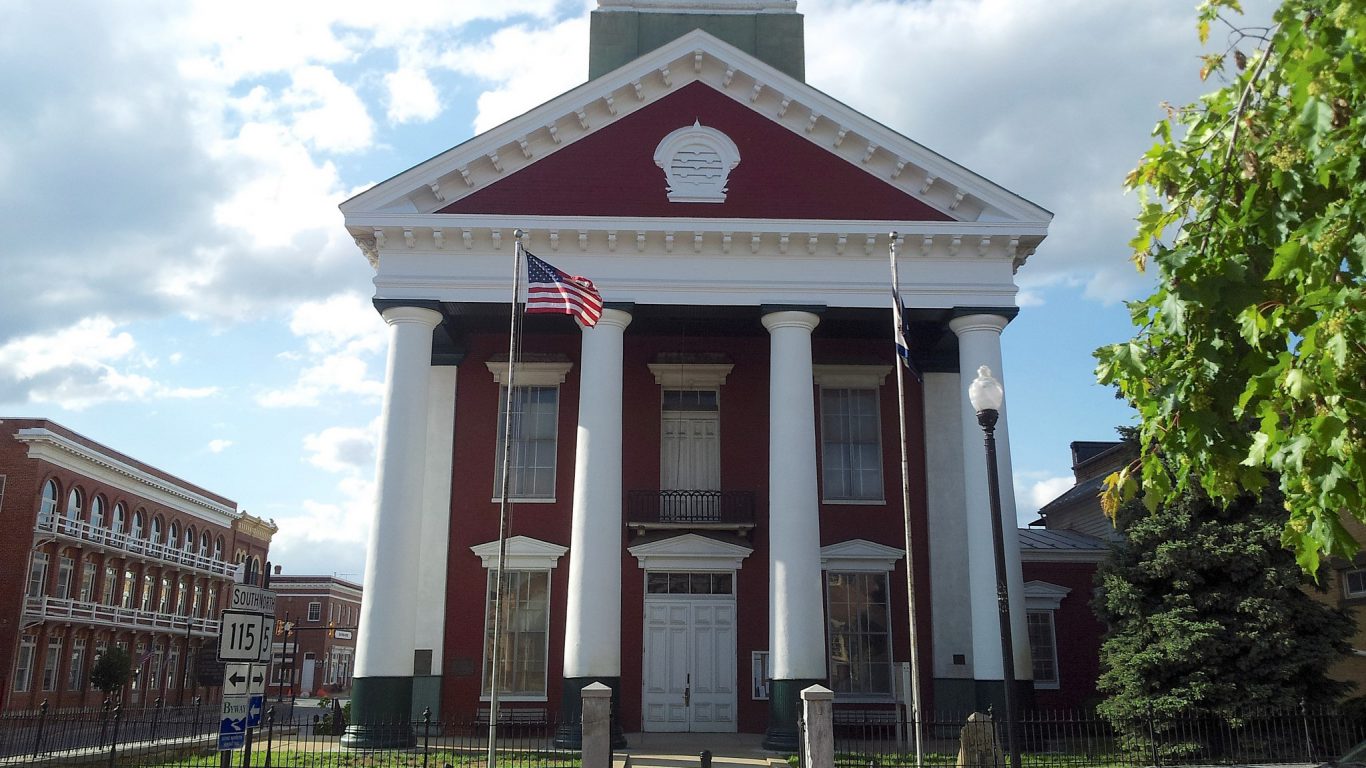
West Virginia: Jefferson County
> 5-yr. population change: +4.0% (state: -0.7%)
> Poverty rate: 9.9% (state: 17.8%)
> Adults with a bachelor’s degree: 30.5% (state: 19.9%)
> Life expectancy: 77.8 years (state: 76.0 years)
In the measures used to create this index of the best counties to live: life expectancy, poverty, and bachelor’s degree attainment among adults, the state of West Virginia compares unfavorably to most of the rest of the country. Even Jefferson County, the state’s best county by these measures, does not rank especially highly among all U.S. counties.
Jefferson County, which is in the easternmost part of the state, has an adult bachelor’s degree attainment rate of 30.5%, which is well above the state rate of 19.9% but slightly below the national share of 30.9%. Life expectancy in the county is 77.8 years at birth, which is higher than the state’s 76.0 year average life expectancy but less than the national life expectancy of 79.1 years.
See all stories featuring: West Virginia

Wisconsin: Ozaukee County
> 5-yr. population change: +1.6% (state: +1.3%)
> Poverty rate: 5.9% (state: 12.3%)
> Adults with a bachelor’s degree: 47.7% (state: 29.0%)
> Life expectancy: 82.1 years (state: 79.8 years)
Ozaukee County, the best county to live in Wisconsin, is located along the shore of Lake Michigan, just north of Milwaukee. It is one of the more affluent places in both the state and the nation as a whole. The county’s median annual household income of $80,526 is about $24,000 higher than the statewide median. Just 5.9% of the county’s population lives in poverty, compared to a state poverty rate of 12.3%. Life expectancy in the county is also about two years longer than the 80 year average across Wisconsin as a whole.
See all stories featuring: Wisconsin
[in-text-ad-2]

Wyoming: Teton County
> 5-yr. population change: +7.5% (state: +3.6%)
> Poverty rate: 6.8% (state: 11.1%)
> Adults with a bachelor’s degree: 54.1% (state: 26.7%)
> Life expectancy: 83.5 years (state: 78.6 years)
Teton County, the best county to live in Wyoming, largely comprises federal land like Yellowstone National Park and Grand Teton National Park.
Residents of Teton County are some of the least likely to face financial hardship. Just 1.9% of households in the area live on less than $10,000 annually — one of the smallest shares in the country and well below the 6.7% share of households nationwide. Financial security is closely tied to educational attainment, and with a bachelor’s degree attainment rate of 54.1%, Teton County’s population is one of the best educated in America.
See all stories featuring: Wyoming
Get Ready To Retire (Sponsored)
Start by taking a quick retirement quiz from SmartAsset that will match you with up to 3 financial advisors that serve your area and beyond in 5 minutes, or less.
Each advisor has been vetted by SmartAsset and is held to a fiduciary standard to act in your best interests.
Here’s how it works:
1. Answer SmartAsset advisor match quiz
2. Review your pre-screened matches at your leisure. Check out the advisors’ profiles.
3. Speak with advisors at no cost to you. Have an introductory call on the phone or introduction in person and choose whom to work with in the future
Get started right here.
Thank you for reading! Have some feedback for us?
Contact the 24/7 Wall St. editorial team.
 24/7 Wall St.
24/7 Wall St. 24/7 Wall St.
24/7 Wall St. 24/7 Wall St.
24/7 Wall St. 24/7 Wall St.
24/7 Wall St. 24/7 Wall St.
24/7 Wall St. 24/7 Wall St.
24/7 Wall St. 24/7 Wall St.
24/7 Wall St.

